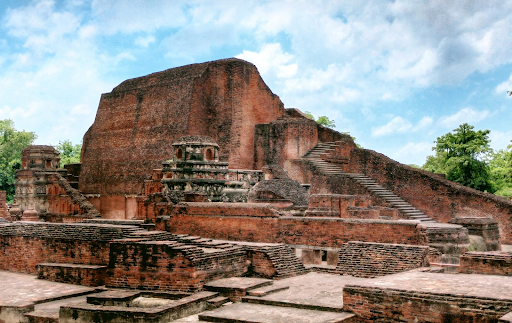Nalanda University: A Beacon of Ancient Wisdom
The history of education is adorned with illustrious institutions that have shaped human thought and civilization. Among these, Nalanda University stands as a monumental symbol of knowledge and intellectual pursuit. Founded in the 5th century CE in the region of Bihar, India, Nalanda University was not merely an educational institution but a thriving center of academic excellence that attracted scholars from across Asia. This blog delves into the profound impact of Nalanda University on the ancient and modern world, its architectural grandeur, academic curriculum, and the eventual decline and revival of this ancient seat of learning.
Historical Context and Foundation
The establishment of Nalanda University dates back to the reign of the Gupta Empire, specifically under the patronage of Kumaragupta I (415-455 CE). This period, often referred to as the Golden Age of India, saw significant advancements in art, culture, and education. Nalanda was founded as a Mahavihara, a large monastic university that embodied the synthesis of religious and secular education.
Geographical and Cultural Setting
Nalanda was strategically located in the Magadha region, which was a crucible of intellectual and spiritual activity. The proximity to the Ganges river facilitated trade and communication, making it accessible to scholars and pilgrims. This strategic positioning played a crucial role in the university's rise as a global center of learning.
Architectural Grandeur and Infrastructure
The architectural brilliance of Nalanda University is well-documented through archaeological excavations and historical accounts. Spread over several acres, the university campus featured red brick buildings, stupas, viharas (monasteries), temples, and extensive libraries.
Monastic Complexes and Temples
The monastic complexes were the heart of Nalanda, comprising individual cells for monks, lecture halls, meditation centers, and large courtyards. The temples, adorned with intricate carvings and sculptures, reflected the zenith of Gupta architectural style.
Libraries: The Dharmaganja
The libraries of Nalanda, collectively known as Dharmaganja, were unparalleled in the ancient world. They housed millions of manuscripts on diverse subjects including theology, philosophy, astronomy, and medicine. The three main libraries – Ratnasagara, Ratnadadhi, and Ratnaranjaka – were repositories of immense scholarly wealth.
Academic Curriculum and Pedagogy
Nalanda's academic curriculum was comprehensive and interdisciplinary, catering to a wide array of subjects. The university was renowned for its rigorous intellectual environment and esteemed faculty, which included eminent scholars such as Aryabhata, Dignaga, Dharmapala, and Shantarakshita.
Curricular Structure
The curriculum encompassed both religious and secular studies. Buddhism, particularly the Mahayana tradition, was a central focus, but the university also offered courses in Vedas, logic, grammar, medicine, mathematics, astronomy, and art. This interdisciplinary approach fostered a holistic educational experience.
Pedagogical Methods
Teaching at Nalanda was characterized by interactive and discursive methods. The medium of instruction was Sanskrit, and education was imparted through lectures, debates, discussions, and commentaries. The presence of students from diverse cultural backgrounds enriched the intellectual discourse.
Global Influence and Scholarly Exchange
Nalanda University was a beacon of international education, attracting scholars from Korea, Japan, China, Tibet, Indonesia, Persia, and Turkey. This global appeal was a testament to its academic excellence and the cosmopolitan nature of its scholarship.
Notable Scholars and Pilgrims
Among the many international scholars, the Chinese pilgrim Xuanzang (Hiuen Tsang) stands out. His detailed accounts provide invaluable insights into the academic life and infrastructure of Nalanda. Xuanzang spent several years at Nalanda, studying and translating Buddhist texts, and his works highlight the university's significant role in the transmission of knowledge.
Cultural and Intellectual Exchange
Nalanda facilitated a vibrant exchange of ideas and knowledge across cultures. This intellectual cross-pollination contributed to the spread of Buddhism and Indian philosophy across Asia, influencing educational systems and philosophical thought in distant lands.
Decline and Destruction
The decline of Nalanda University was precipitated by a combination of political and military upheavals. The invasions by the Turkic general Bakhtiyar Khilji in the 12th century CE resulted in the catastrophic destruction of the university.
Factors Leading to Decline
The fall of the Pala Empire, which had been patrons of Nalanda, weakened the institution's political support. Subsequent invasions by Muslim armies led to widespread destruction, with the libraries being set ablaze and many scholars being killed or forced to flee.
Impact of Destruction
The destruction of Nalanda marked a significant loss to global heritage. The burning of the libraries, reportedly lasting for several months, led to the irreplaceable loss of manuscripts and texts that encapsulated centuries of knowledge and research.
Rediscovery and Contemporary Revival
In recent years, there have been concerted efforts to revive Nalanda as a center of learning. The establishment of the Nalanda University in 2010, under the Nalanda University Act, aims to recreate the ancient institution's spirit of global education and intellectual exchange.
Contemporary Nalanda University
The modern Nalanda University, situated near the site of the ancient university, aspires to be an international hub of academic excellence. It focuses on interdisciplinary research, fostering an environment of intellectual rigor and cultural diversity.
Significance in Modern Education
The revival of Nalanda University serves as a symbol of India's rich educational heritage and its enduring commitment to global scholarship. It underscores the importance of preserving historical knowledge and fostering intellectual collaboration across borders.
Conclusion
Nalanda University stands as a testament to the timeless quest for knowledge and enlightenment. Its legacy transcends the annals of history, continuing to inspire contemporary education systems worldwide. The story of Nalanda is not just about a university; it is about the enduring human spirit to learn, teach, and share knowledge across generations and cultures. As we delve into the rich tapestry of Nalanda's history, we are reminded of the profound impact that a single institution can have on the world, shaping the course of intellectual and cultural evolution for centuries to come.

Comments